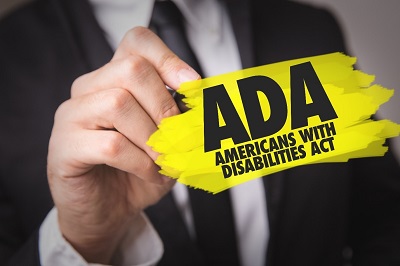When Is ADA Compliance Legally Required?
The ADA (Americans with Disabilities Act) provides certain protections for those with disabilities to provide an equal opportunity to access, like for people without disabilities. For business owners, it is important to understand when you are legally required to be ADA-compliant.
The ADA applies to organizations and businesses that fit one or more of the following criteria:
- All local, county, state, and federal government agencies.
- Any business that relies on the general public or for their benefit.
- Privately run companies that currently have 15 or more employees.
- Non-profit and charitable organizations which either have 15 or more employees or which operate for the benefit of the general public.
A good general guideline you can use to determine if your business should be ADA-compliant is to answer this question: “Does your business or organization have places or areas that are designed for public accommodation?”

Public accommodation is defined broadly and could include one or more of the following types of businesses or locations:
- Retail Stores
- Restaurants
- Public Parks
- Public Restrooms
- Airports
- Train/Rail/Subway Stations and Terminals
- Bus Stations and Terminals
- Healthcare Facilities and Hospitals
- Resorts, Hotels, and Motels
- Apartment and Rental Properties: View the ADA Requirements for Apartment Buildings
- Public Sidewalks
- Parking Garages
- Sports Stadiums/Arenas
- Schools/Colleges/Universities
Essentially, any areas where people have access without any restrictions should follow the ADA requirements. It is equally important to remember that privately run businesses that do not rely on the general public or function for their benefit can still be bound by the ADA, so long as they have 15 or more people in their employ.
How Can a Business Verify ADA Compliance?
The Department of Justice (DOJ) oversees the ADA requirements. The DOJ highly recommends businesses and organizations perform their own self-evaluations to determine whether their operations meet current ADA standards of compliance.1
To help get you started, let’s look at a general overview of what you can do:
- Step 1: Create a floor plan for your business and its layout.
You can sketch this or make one on the computer—whatever is easier for you. On the floor plan, make sure to include the location of furniture, doorways, entryways, elevators, stairways, and so on. Be as detailed as possible to include every aspect. - Step 2: Review the floorplan layout.
The next step requires gathering a tape measure and taking measurements. You need to measure the width of doors, aisles, and other areas people walk through. These areas should be wide enough to accommodate people in wheelchairs, without any obstructions.
In addition, in bathrooms, there should be at least one stall with a door wide enough to accommodate a wheelchair. The toilet in this stall also needs to be installed at the correct ADA-required height and include handrails. You will also need at least one sink installed that is accessible from a wheelchair. - Step 3: Make a list of action items that need to be addressed.
As you are walking around your business and taking measurements, make a note of anything that does not meet current ADA measurement requirements. These items will need to be corrected in order to ensure ADA compliance. - Step 4: Put yourself in the place of a person with disabilities.
A great way to tell how disabled-friendly is your business would be to get a wheelchair and use this to get around. Can you open doors easily and get in and out without any obstructions or problems? Are there specific areas where corners seem tight? You could also put on a blindfold and use a cane to walk around to see whether there are concerns or issues you need to address for people with visual impairments. - Step 5: Don’t forget to do an assessment outside of your building.
ADA requirements extend to the exterior of your business, as well. You need to make sure accessing your building is possible. Two areas of importance are parking lots and sidewalks. Parking lots should have a certain percentage of handicap-accessible parking spaces that are clearly marked and fairly close to the main entrance.These spaces have to be wide enough to accommodate a van with a wheelchair lift. Additionally, there should be a clearly defined ADA walkway or crossing for people to use to cross traffic and gain access to your building.For a sidewalk, there needs to be a ramp for access to your building. The ramp should be near the main entrance and not hidden on the side or back where getting to it can be difficult. Ramps have to be at a specific incline and should include some type of ADA-detectable warning surface, like truncated domes.There are different types of ramps allowed under the ADA. As such, each one has its own specific requirements regarding width, placement, and so on, which you will need to review. In some settings, you may also be required to install handrails on the exterior of ramps.
Please keep in mind, this is just a general overview and does not include every specific requirement you may need to consider for your business.
The ADA offers different checklists that can be used for existing structures as well as new construction. In some cases, an existing structure may fall under previous ADA requirements, depending on when it was built. However, if any renovations or updates are made to the facility, then the business could be required to bring all ADA standards up to date using the current requirements.

What Areas Should Be Given Priority for ADA Compliance?
The ADA recommends breaking down your facility into four different priority areas when creating your checklist.2 The top priority is accessibility to approaching and entering the building. If people cannot access your building, then it will not matter what areas of your building are ADA-compliant.
The second priority is in regards to what type of access people with disabilities have to services, goods, and products your business offers. Basically, is it easy for them to get around and obtain the things they need? Or are there obstacles in their way that you need to resolve?
Your third priority is the accessibility of restrooms. You only need to worry about bathrooms if you offer the general public access to them or have 15 or more people in your employ.
The fourth priority applies to other areas of your building and business, such as:
- Elevator Call Buttons and Control Panels
- Public Telephones
- Self-Help Building Directories
- Self-Service Kiosks
- Drinking Fountains
- Vending Machines
- Employee Break Areas
Don’t forget, the ADA covers more than just accessibility for people with disabilities. It also applies to employment opportunities, internet websites, and more. This is why you will want to obtain a copy of the current standards and review these in detail to see which ones apply to your business.

Where Can I Obtain ADA Flooring and Warning Surface Products?
Detectible warning surface must be installed in areas where there is a public right-of-way, like store entrances, crosswalks, walkways in parking lots, and so on. When looking for ADA flooring with raised tactile domes and warning surfaces, you need to make sure the supplier’s products meet all current ADA regulations and specifications.
At ADA Solutions, all of our products satisfy all current ADA requirements and specifications. We even offer a wide range of colors of tactile warning surfaces. While the ADA does not have any requirements regarding colors, except that they contrast with light and dark, some cities and states do have specific ordinances and laws that require businesses to use a specific color.
We offer ADA detectable warning surface products for existing sidewalks and walkways that can be installed over the surface. We also offer cast-in-place solutions for newly poured sidewalks and walkways, as well as replaceable panel options.
To learn more about our ADA-compliant surface products or assistance in selecting the right ones for your business, please feel free to contact ADA Solutions at (800) 372-0519 today!



